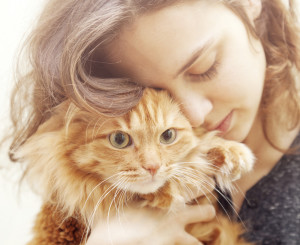Cats often become reclusive and hide when they are not feeling well which makes knowing when they need to be seen by your veterinarian a challenge. They have unique signs and symptoms of emergency conditions that often go unrecognized by their owners. Some injuries are obvious, such as a cat with an open wound, while others have more subtle signs that can be equally deadly if left untreated. Knowing what signs to look for is crucial in determining when to seek emergency care for your cat. Below is a list of some of the most common cat emergencies and their signs.
Urethral Obstruction
This is a condition in which a cat, usually male, is unable to urinate due to a blockage in the urethra (the tube leading from the urinary bladder to the outside environment).
Cats will show a sudden onset of restless behavior which includes frequent trips in and out of the litter box. They will often attempt to urinate in unusual places such as in a bath tub or on a plastic bag. You may notice a very small stream of urine that contains blood. More often than not, despite a cat’s straining, there may be no urine or even just a drop produced. In later stages of the obstruction, cats may cry loudly, vomit, and become lethargic.
You should consider these signs a serious emergency and seek veterinary care immediately. There are reports of cats developing kidney failure and dying within 12 hours after the onset of signs. Expect your cat to be hospitalized at least 36 hours for treatment of this condition which may include a urinary catheter, intravenous fluids, and pain management. Female cats are less likely to become obstructed due to their wider urinary tract.
Toxicities (Poisoning)
The combination of their curious nature and unique metabolism (the way their body breaks down chemicals) makes cats very vulnerable to toxins. Owners are often not aware that their home contains multiple products that are poisonous to their feline companions. The most common cat toxins include antifreeze, Tylenol, and rat or mouse poison.
The signs your cat displays depends on what type of poison they have encountered. Antifreeze will often cause wobbliness or a drunken appearance first, then progresses to vomiting/weakness as the kidneys fail. Tylenol may cause an unusual swelling of the head and changes the cats blood color from red to chocolate brown. Rat or mouse poison interferes with blood clotting so you may see weakness from internal blood loss or visible blood in urine or stool.
Breathing Problems
Many times cats hide the signs of breathing problems by simply decreasing their activity. By the time an owner notices changes in the cat’s breathing, it may be very late in the progression of the cat’s lung disease. There are several causes of breathing changes but the most common are feline asthma, heart or lung disease.
Foreign Object Ingestion
As you know cats love to play with strings or string-like objects (such as dental floss, holiday tinsel, or ribbon), however, you may not know the serious danger that strings can pose to your cat. When a string is ingested, one end may become lodged or “fixed” in place, often under the cat’s tongue, while the remaining string passes farther into the intestine. With each intestinal contraction, the string see-saws back and forth actually cutting into the intestine and damaging the blood supply.
Signs that your cat has eaten a foreign object may include vomiting, lack of appetite, diarrhea, and weakness. Occasionally owners will actually see part of a string coming from the mouth or anal area. You should never pull on any part of the string that is visible from your pet.
Most times emergency surgery is necessary to remove the foreign object and any damaged sections of intestine.
Bite Wounds
Cats are notorious for both inflicting and suffering bite wounds during encounters with other cats. Because the tips of their canine, or “fang”, teeth are so small and pointed, bites are often not noticed until infection sets in several days after the injury.
Cats may develop a fever and become lethargic 48 to 72 hours after experiencing a penetrating bite wound. They may be tender or painful at the site. If the wound becomes infected or abscessed, swelling and foul-smelling drainage may develop.
You should seek emergency care for bite wounds so that your veterinarian may thoroughly clean the area and prescribe appropriate antibiotics for your pet. Occasionally the wounds will develop large pockets called abscesses under the skin that require surgical placement of a drain to help with healing.
Hit by car
Cats that spend time outdoors are at a much greater risk for ending up in the emergency room. Being hit by a car is one of the most common reasons for your pet to suffer traumatic injuries such as broken bones, lung injuries and head trauma. You should always seek emergency care if your cat has been hit by a vehicle even if he or she appears normal as many injuries can develop or worsen over the next few hours.
Increased Thirst and Urination
Sudden changes in your cat’s thirst and urine volume are important clues to underlying disease. The two most common causes of these signs are kidney disease and diabetes mellitus.
Your veterinarian will need to check blood and urine samples to determine the cause of your cat’s signs. Having your pet seen on an emergency basis for these signs is important as the sooner your pet receives treatment, the better their chances for recovery. Many times exposure to certain toxins, such as antifreeze or lilies, will show similar signs and delaying veterinary care can be fatal.
Sudden inability to use the hind legs
Cats with some forms of heart disease are at risk for developing blood clots. Many times these clots can lodge in a large blood vessel called the aorta where they can prevent normal blood flow to the hind legs. If your cat experiences such a blood clotting episode (often called a saddle thrombus or thromboembolic episode), you will likely see a sudden loss of the use of their hind legs, painful crying, and breathing changes.
On arrival at the emergency room, your pet will receive pain management and oxygen support. Tests will be done to evaluate the cat’s heart and determine if there is any heart failure (fluid accumulation in the lungs). Sadly, such an episode is often the first clue for an owner that their cat has severe heart disease. In most cases, with time and support, the blood clot can resolve, but the cat’s heart disease will require life-long treatment.
Upper Respiratory Infections
Cats and kittens can experience a variety of upper respiratory diseases caused by a combination of bacteria or viruses. Upper respiratory infections, or URIs, often cause sneezing, runny noses, runny eyes, lack of appetite, and fever. In severe cases, they can cause ulcers in the mouth, tongue, and eyes. More often than not, severe cases are seen in cats that have recently been in multiple-cat environments such as shelters. Small or poor-doing kittens are also easily infected and may develop more severe complications such as low blood sugar.
Sudden Blindness
A sudden loss of vision is most likely to occur in an older cat. The most common causes are increased blood pressure (hypertension) that may be due to changes in thyroid function (hyperthyroidism) or kidney disease. There are some cats that appear to have hypertension with no other underlying disease.
Sudden blindness should be treated as an emergency and your veterinarian will measure your cat’s blood pressure, check blood tests, and start medications to try to lower the pressure and restore vision.
Anytime you notice a change in your cat’s eyes, whether they lose vision or not, you should consider this an emergency have your pet seen by a veterinarian as soon as possible.
SOURCE: http://www.cathealth.com/safety/top-ten-emergencies-in-cats



